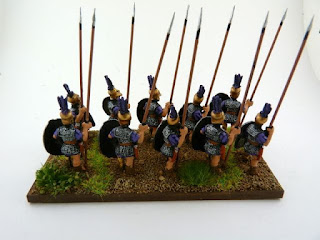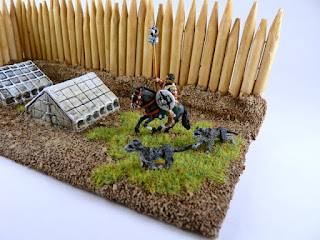During my Mid Roman Republic project, I kept stumbling across the fascinating story of King Mithridates of Pontus. The kingdom of Pontus was situated in what is now northern Turkey. The map below shows the Pontic kingdom before the first Mithridatic campaign (in purple) and Pontic kingdom after the early conquests (in pink). A reading of all the provinces and city-states in pink illustrates why the Pontic army was such a cornucopia of exotic troops and fighting styles
As King of Pontus, Mithridates styled himself after Alexander the Great and even acquired a cloak reportedly worn by Alexander. His expansionist policies put him on a collision course with Rome. The little bit I learned about the man left me wanting more so I went hunting for books on this subject. Oddly, there are only 2 current books on Mithridates but the lack of quantity is made up for by the quality of the reads below.
The Poison King: The Life and Legend of Mithridates, Rome's Deadliest Enemy. This is a quick and thoroughly enjoyable read on the life and campaigns of Mithridates. You don't have to be a military history buff to enjoy the story of Mithridates. The author supplements what is known about the man with historical research and archaeological discoveries to reconstruct what his life was probably like. I had no problem with the use of reasoned speculation to fill in the gaps of history. On the contrary, this kind of writing helped put me in the period and the author clearly flags her speculation. Frankly, this would not be much of a book without it as there isn't much known of Mithridates outside of Roman accounts. In this book you'll learn that:
- Mithridates led three campaigns against Rome.
- In his first campaign, he seized much of what is now modern-day Turkey and Greece.
- He orchestrated the massacre of 80,000 Roman citizens throughout Asia minor in a single day.
- The wealth of his kingdom was so well known in Rome that the Republic was split asunder when Marius and Sulla each vied for the opportunity to lead legions to conquer and plunder Pontus.
- Mithridates dosed himself with small amounts of poison throughout his life to build up his tolerance. He also invented a complex universal antidote which the Romans reportedly copied after his death called Mithridadicum.
- Spoiler Alert! While Mithridates ultimately failed, it wasn't for a lack of effort or imagination. In his first campaign, he reintroduced scythed chariots to the battlefield, something not seen for a generation or two. In his second campaign, he employed Roman ex-pats to reform and retrain his army to fight in the Romans style. He also started leading from the front. In his third campaign, he utilized asymmetrical hit and run guerrilla warfare.
- For a man who was repeatedly a thorn in the side of Rome, he managed to live long enough to die old.

Mithridates the Great: Rome's Indomitable Enemy. While described as a biography, this book is more of a military history and account of the campaigns. If you want to learn about the man, the era, the customs and his empire,
The Poison King is a better read. If you want battle maps and accounts of the troops, tactics and styles of fighting, this book adds the military detail that's lacking from
The Poison King. Together, these books make a great pair.
With the hook firmly set, I turned to the
Impetus website and pulled the Pontic army list.
It's a broad and varied list that gives you the building blocks for other ancient armies. With a little work, my Pontic army can become a Pyrrhic army. A little more painting and its a Gallic army. A few units here and there and I have a Macedonian or Seleucid army. Portability? Check. Varied troop types for playing and painting? Check and check. The Pontic project is a go!
Because the Pontic army was a blending of East and West, you have many options for modeling it. I'll emphasize the "Hellenistic" side. For example, I'll use Xystophoroi Cavalry to represent the heavy cavalry that Mithridates rode with in this list. You could easily choose Persian heavy cavalry though. One of the benefits of painting and gaming ancients is that you get to choose your own path in painting and modelling your armies within the limits of what's known. Try pulling THAT with Napoleonics!
I'm utilizing
Xyston figures for most of this army, which is a huge plus because I love their figures. Also, I'm utilizing 3D basing for the first time to vary the level of the base/terrain. Props to
Der Figurenschiber and his tutorial for basing in 3D! I should also mention he has the finest 15mm Thracian army I've ever seen as well.
Before I call it a post, here's a preview of my first crack at 3D basing with Balearic Slingers. Not too shabby!





















































